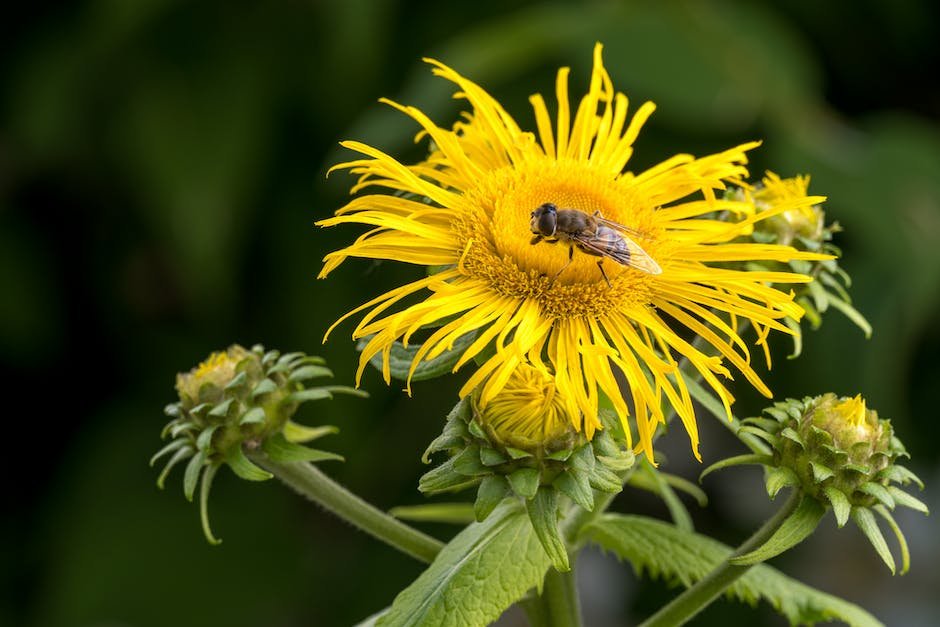Contents
Elecampane, or Inula helenium, is a tall herbaceous perennial plant in the family Asteraceae. The showy, orange-yellow flower heads, which are up to 20 cm (8 in) in diameter, are borne in summer and autumn on thick, hairy stems up to 2.5 metres (8 ft) tall. The plant’s large, deeply-lobed leaves are covered with downy hair, and have a strong, pleasing herbal smell when crushed. Elecampane is native to Europe and Asia, and has been introduced to North America.
Elecampane (Inula helenium) is a tall herbaceous perennial plant with a large, fleshy, yellow taproot. The leaves are broad and wrinkled, with a long petiole. The plant produces numerous small yellow florets that appear in a large, branched, flat-topped inflorescence. The fruits are achenes that are each attached to a pappus of white capillary bristles.
What is elecampane herb used for?
Elecampane is an herb that has a long history of use in treating lung diseases. The root is used to make medicine, and it is thought to work by helping to loosen phlegm and making it easier to cough up. Elecampane is also an expectorant, which means it helps to thin mucus and make it easier to expel from the lungs. It is commonly used for bronchitis, asthma, and whooping cough, and is also sometimes used to prevent coughing caused by tuberculosis.
When taken by mouth, elecampane is possibly safe for most adults. However, large amounts of elecampane are possibly unsafe and can cause vomiting, diarrhea, spasms, and paralysis.
Can you eat elecampane
Elecampane can be candied and eaten like candied ginger. It is said to be good for coughs and nausea. I have not personally tried it, but my friends say it is mild and sweet.
Edible Parts
The leaves and roots of the plant are edible. The leaves are better off cooked than raw as they are bitter. The roots contain up to 44% inulin so for some, this many cause gas. If thinly sliced, the roots can be candied.
Who should not take elecampane?
Elecampane root is a herbal remedy that has been used for centuries for its medicinal properties. However, there is lack of scientific evidence to support its use and safety. Therefore, people on medications for blood pressure or blood sugar management, those who have a sensitivity to Compositae plants, and people who are pregnant or breastfeeding should avoid elecampane root.
There are many medicinal plants that have traditionally been used to treat respiratory disorders. Some of these plants include Aesculus indica, Ageratum conyzoides, Albizia lebbeck, Alhagi maurorum, and many others. These plants have been used for centuries to help treat coughs, colds, and other respiratory problems.
What is the best herb for upper respiratory infection?
Echinacea is most commonly used to boost the immune system and help fight off upper respiratory tract infections, such as the common cold. It is thought to work by stimulating the production of white blood cells, which help fight off infection. Echinacea is available in a variety of forms, including capsules, tablets, teas, and tinctures. The most commonly used type is Echinacea purpurea.
Astragalus, pippali, licorice, Kalmegh, and Vasaka are all great herbs for boosting respiratory health. They can help to treat common respiratory problems, and also improve overall lung function. These herbs are also anti-inflammatory, so they can help to reduce swelling and irritation in the airways. If you have respiratory problems, or are looking to improve your lung health, try incorporating these herbs into your diet or taking them in supplement form.
What is the best herbal medicine for lungs
If you’re looking for herbs to support your lung and respiratory health, consider adding some of the following to your list: 1) Schisandra 2) Yarrow 3) Black Seed Oil 4) Plantain 5) Licorice 6) Mullein 7) Gaia-Grown Nettle 8) Oil of Oregano. All of these herbs have traditionally been used to support respiratory health and can be taken in a variety of ways (teas, tinctures, capsules, etc). Speak with a qualified healthcare practitioner to determine which form and dosage is best for you.
The root of elecampane is a powerhouse of soluble fiber inulin. It is also rich in other nutrients like potassium, calcium, and magnesium. The root is thick, branching, and gelatinous in nature with a hint of camphor scent. The taste of elecampane is quite strong, bitter, and pungent. Its strong flavor is due to the high concentration of essential oils like alantolactone, isoalantolactone, and camphor. Elecampane is a popular herbal medicine in many cultures and has a wide range of health benefits.
What does elecampane tea taste like?
If you have lung crud, elecampane is the herb for you! It tastes like peppery mud, but it is effective in treating lung crud.
Elecampane was cultivated and consumed for centuries throughout the Middle Ages as a medicinal plant. The plant was used as an aromatic tonic and stimulant of the secretory organs for coughs, bronchitis, asthma and whopping cough. Elecampane was also used as a condiment early as the Middle Ages. The plant is still used medicinally today and has shown to be effective in treating respiratory conditions.
What can you do with elecampane leaves
Herbalists have traditionally used elecampane to treat various coughs, including those associated with bronchitis, asthma, and whooping cough. Elecampane is also known to help improve digestion and relieve general intestinal complaints.
The elecampane root is a great addition to many different foods and beverages. It can be mixed into granola or hot lemon water for a quick and easy boost. It is also becoming increasingly popular to add elecampane root to juices and smoothies.
How do you make elecampane tea?
Elecampane tea is a great way to get relief from a cough. The root of the elecampane plant is full of antioxidants and anti-inflammatory properties that make it a great natural remedy for a cough. To make elecampane tea, simply boil a quart of water and add 2 tablespoons of dried elecampane root. Simmer for 20 minutes, then add honey and a splash of lemon juice to taste. This tea will help to soothe your throat and ease your cough.
Elecampane is a herbaceous plant that is indigenous to Europe and Asia. It is found in damp woods, hedges and meadows. The plant grows up to 1.5 meters tall and has hairy, dark green leaves that are toothed at the edges. The flowers are golden-yellow in color and bloom from July to September. Elecampane has a long, thin taproot that is brown on the outside and white on the inside. This root is the part of the plant that is used medicinally.
Elecampane is traditionally used as a remedy for bronchitis, coughs and chest infections. It is thought to work by thinning the mucus in the lungs and making it easier to expectorate. The herb is also used to treat stomach and intestinal problems such as gas, bloating and diarrhea.
Is elecampane a diuretic
Elecampane is a medicinal plant that has been used for centuries by herbalists for its antiseptic, expectorant, diuretic, and immune system booster properties. Greek mythology solidified the plant’s rank amongst medicinal plants, and over the centuries, elecampane has been used to treat various ailments. Today, elecampane is still used by some people to treat respiratory disorders and other conditions.
Herbal preparations are sometimes recommended for the treatment of various medical conditions, but it is important to remember that many of these herbs have not been extensively studied and may not be safe for human consumption. Some herbs that have been identified as unsafe include borage, calamus, coltsfoot, comfrey, life root, sassafras, chaparral, germander, licorice, and ma huang. While some of these herbs may have potential benefits, they also come with numerous risks that make their use not worth the potential rewards. If you are considering taking any herbal preparations, be sure to speak with your healthcare provider first to ensure that they are safe for you to take.
What herbs remove mucus from lungs naturally
Herbal teas can be a great way to help get rid of phlegm. Mint, thyme, chamomile, and echinacea are all great options. Elderberry can also be helpful. Our Echinaforce Hot Drink can be a great way to get rid of persistent mucus. Just add one teaspoon to a cup of hot water and enjoy!
Certain dietary supplements have been shown to promote lung health, especially among those with conditions that affect the lungs. These supplements include vitamin C, vitamin D, magnesium, omega-3s, zinc, and selenium. Taking these supplements may help improve symptoms and improve lung function.
How do you get rid of mucus in your lungs naturally
There is no one definitive answer to this question as everyone may have different preferred methods for draining mucus from their lungs. However, some suggested techniques include keeping the air moist, drinking plenty of fluids, and applying a warm, wet washcloth to the face. Additionally, keeping the head elevated and not suppressing a cough can also help to loosen and clear mucus from the lungs. Finally, using a saline nasal spray or rinse and gargling with salt water can also be effective in reducing mucus buildup.
The respiratory system is designed to keep the lungs and airways clear. However, sometimes mucus can build up and cause problems. There are things you can do to help keep your chest clear.
-keep upright as much as possible unless a physiotherapist advises you to try other positions
-take any medicines you are prescribed
-drink plenty of fluids to stay well hydrated
-keep active and do gentle physical activity
Warp Up
Elecampane is a member of thesunflower family and its scientific name is helenium autumnale. Elecampane is a tall herb that grows to a height of about two meters. It has large yellow flowers and its leaves are toothed and hairy. The plant is native to Europe, but it is also found in North America. Traditionally, elecampane has been used for a variety of purposes, including as a treatment for respiratory problems such as bronchitis and asthma.
The Elecampane Plant is a large herb that grows in the northern hemisphere. It has yellow or white flowers and a strong, aromatic root. The root is used to make medicine. Elecampane is used to treat digestive problems including stomachache, gas, heartburn, diarrhea, and constipation. It is also used to treat coughs, colds, bronchitis, and other respiratory infections.

0 Comments